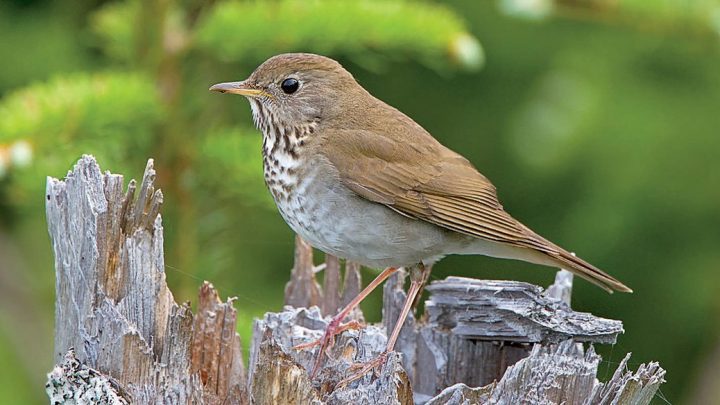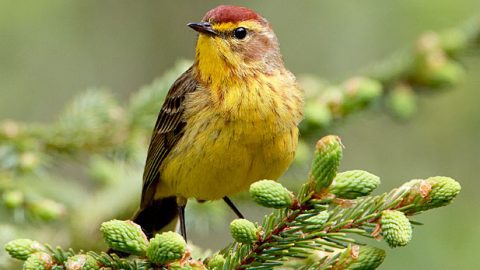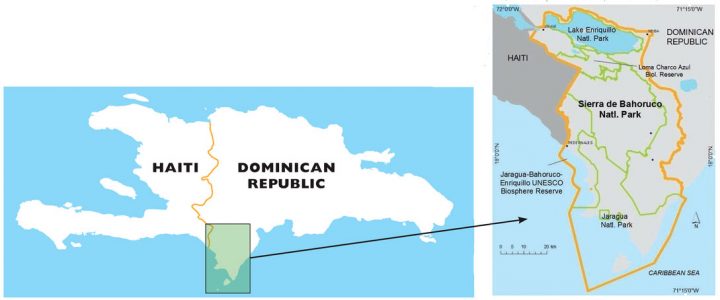Illegal Deforestation Continues in the Dominican Republic; Threatens Bicknell’s Thrushes
By Tim Gallagher
From the Summer 2015 issue of Living Bird magazine.
July 15, 2015
Sierra de Bahoruco National Park is a vital haven for some of the rarest endemic birds in the Caribbean Basin—such as the La Selle Thrush, Western Chat-Tanager, and White-winged Warbler. But its cloud-forest habitat is being illegally logged and cleared for crops. And conservationists say the government of the Dominican Republic is doing little to stop it.
An important section of the UNESCO Jaragua-Bahoruco-Enriquillo Biosphere Reserve, the park was established to protect more than 400 square miles of mostly forested mountains on the island of Hispaniola. It is one of the most biologically diverse areas in the Caribbean—a crucial refuge for many endemic animals, plants, and insects, some of which are doubtless still unknown to science.
Living Bird science editor Hugh Powell reported on illegal farming in Bahoruco two years ago in our All About Birds blog, but sadly, the deforestation continues. At the time of his blog post, in April 2013, Powell wrote that some 30 square miles of forest in the park had been destroyed. That figure is rising quickly.
People are cutting down trees inside the park boundaries with seeming impunity, destroying pristine tracts of cloud forest to make charcoal and to clear the way for planting avocado trees, beans, corn, and other crops. The worst of the destruction is not being done by local subsistence farmers but by commercial agricultural interests that take over forest plots, hire people to clear them, and make arrangements with tenant farmers—often from the poorer nation of Haiti, which shares the island of Hispaniola with the Dominican Republic. These sharecroppers do all of the dirty work in exchange for a mere 20 percent of the crop.
According to Chris Rimmer, executive director of the Vermont Center for Ecostudies, several endemic birds of Hispaniola depend on the cloud-forest habitat now being destroyed at Bahoruco. Rimmer has spent 20 years in Bahoruco studying the winter ecology of the Bicknell’s Thrush, one of the rarest and most threatened songbirds of the northeastern United States and southeastern Canada. An estimated 80 to 90 percent of these thrushes winter on Hispaniola, and Rimmer says Bahoruco has some of the best available habitat for them.
The Dominican Ministry of the Environment has a legal mandate to maintain and protect the country’s national parks, but the laws are not being enforced. Organizations such as Grupo Jaragua (in the Dominican Republic), Vermont Center for Ecostudies, Cornell Lab of Ornithology, and American Bird Conservancy havepetitioned the ministry to crack down on the illegal activities in Bahoruco.

Journalists are bringing attention to the situation, too. In March Marvin del Cid, a reporter at Diario Libre, the leading newspaper in the Dominican Republic, wrote an article documenting the unabated destruction (see an English translation at http://tinyurl.com/qykkxhq). He and his colleagues used a drone-mounted camera to conduct an aerial inspection of Bahoruco. The photos they obtained are shocking, capturing the deforestation while it was happening, as tenant farmers burned trees to clear the land in preparation for planting crops (see photo on right).
These shortsighted actions affect not only wildlife but people as well. The soil is poor and will be quickly ruined as crops are grown there, and local inhabitants will lose the watershed benefits of the forest. “As more people inhabit the island, water is becoming an increasingly precious resource,” says Rimmer. Without the protection of cloud-forest cover, water loss and erosion will be much greater, which could be catastrophic for Dominicans and Haitians alike.
“It’s time to ratchet up the pressure on the Dominican government by creating media attention and visibility to raise public awareness,” says Rimmer. That might be the only hope for this critically threatened area

All About Birds
is a free resource
Available for everyone,
funded by donors like you
American Kestrel by Blair Dudeck / Macaulay Library




